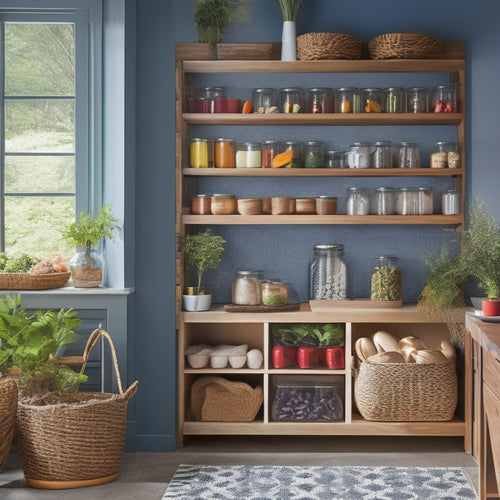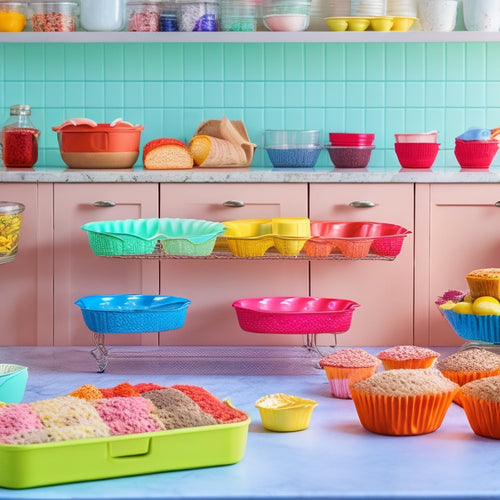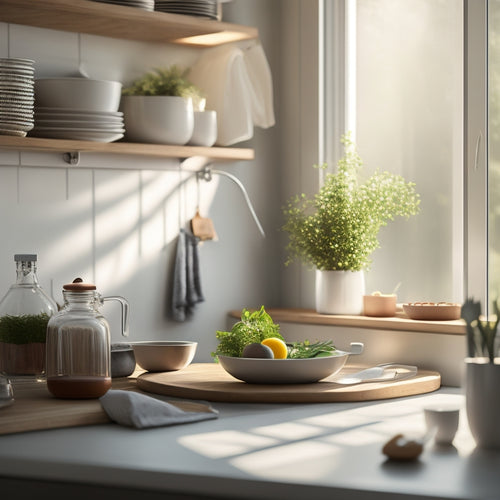
What's Hiding Behind Your Kitchen Counter Clutter?
Share
Behind your kitchen counter clutter, you'll find a multitude of hidden dangers lurking, including expired food, cross-contamination hotspots, and pest-attracting crumbs. These culprits compromise food safety and can even lead to foodborne illnesses. Cluttered counters also attract pests like cockroaches and rodents, making your kitchen an unhealthy environment. By clearing the clutter, you'll not only create a safer space but also uncover a more functional and organized kitchen. But that's just the beginning - there's more to explore in your kitchen's hidden world.
Key Takeaways
• Expiration dates and spoiled leftovers hide behind cluttered counters, posing health risks and compromising food safety.
• Cluttered counters harbor cross-contamination hotspots, attracting pests like cockroaches and rodents, and increasing the risk of foodborne illnesses.
• Kitchen gadgets, appliances, and stacked cookbooks contribute to countertop clutter, taking up valuable space and creating a breeding ground for pests.
• Leaving ingredients out can attract pests, create unpleasant odors, and lead to foodborne illnesses, making it essential to clear counters regularly.
• Mindful decluttering and intentional storage solutions can help create a safe, functional, and healthy kitchen environment that sparks joy and supports well-being.
Hidden Dangers of Cluttered Counters
Cluttered counters can harbor a multitude of unseen threats, from expired food and spoiled leftovers to hidden hotspots for cross-contamination, all quietly waiting to sabotage your health and kitchen hygiene. As you cook and prepare meals, you're not just feeding your family, you're also unknowingly creating an environment that can attract pests and compromise food safety.
You mightn't realize it, but crumb-covered countertops, unwashed dishes, and overflowing trash cans are an open invitation to unwanted guests like cockroaches, rodents, and fruit flies. These pests can spread disease and contaminate food, putting your loved ones at risk.
Additionally, cluttered counters can conceal expired or spoiled food, leading to foodborne illnesses. By clearing your counters and maintaining a clean kitchen, you're taking an important step in ensuring food safety and preventing pest attraction.
It's time to take control of your kitchen and create a safe and healthy environment for those you care about.
Kitchen Countertop Clutter Culprits
As you scan your kitchen countertop, you're likely to spot several culprits contributing to the clutter, from appliances and gadgets to food and ingredients that haven't been put away. These items can quickly add up, creating Countertop Chaos that makes it difficult to cook, clean, and enjoy your kitchen.
Take a closer look and you'll probably find that kitchen gadgets, like blenders and toasters, are taking up valuable real estate. Maybe you have a collection of cookbooks or food magazines that are stacked haphazardly, making your countertop look messy.
Perhaps you've got a habit of leaving ingredients or leftovers out, which can attract pests and create unpleasant odors.
To transform your kitchen into a peaceful haven, it's essential to identify and tackle these clutter culprits. By doing so, you'll be able to create a Kitchen Haven that's organized, functional, and enjoyable.
Take the first step towards a clutter-free kitchen by acknowledging the culprits behind your countertop chaos.
Clearing Clutter With a Purpose
Now that you've identified the culprits behind your kitchen countertop chaos, it's time to roll up your sleeves and start clearing the clutter with a purpose. Mindful decluttering is about more than just getting rid of stuff; it's about creating a space that serves you and your loved ones.
As you begin to clear the clutter, ask yourself: 'What do I want to achieve in this space?' and 'What kind of life do I want to lead?' This intentional living approach will help you focus on what's truly important to you.
Start by categorizing items into keep, donate, and discard piles. Be honest with yourself about each item – when was the last time you used it? Does it bring you joy? Does it align with your values and goals?
As you declutter, imagine the sense of freedom and clarity that comes with a tidy and organized space. Remember, the goal is to create a kitchen that sparks joy, fosters connection, and supports your well-being. By clearing clutter with a purpose, you'll be one step closer to achieving that vision.
Decluttering Strategies for Small Kitchens
Now that you've cleared the clutter, it's time to optimize your small kitchen's layout.
You'll need to get creative with the space you have, and that means making the most of your walls and corners.
Maximizing Vertical Space
Take advantage of your kitchen's often-wasted vertical space by installing shelves, hooks, or a pegboard to store infrequently used items, freeing up valuable counter real estate. This will give you more room to prepare meals and reduce clutter.
| Vertical Space Solution | Benefits |
|---|---|
| Wall Shelves | Store less frequently used items like special occasion dishes, cookbooks, or infrequently used appliances, keeping them out of the way but still accessible. |
| Ceiling Racks | Hang pots, pans, or utensils, keeping them organized and freeing up cabinet space. |
| Pegboard | Hang frequently used items like spices, oils, or utensils, keeping them within easy reach and saving counter space. |
Streamlining Workflow Zones
By identifying and streamlining your kitchen's workflow zones, you can optimize your small kitchen's functionality and reduce clutter. This involves dividing your kitchen into distinct areas, each dedicated to a specific task, such as food prep, cooking, and cleanup.
This task segmentation allows you to focus on one task at a time, reducing mental and physical fatigue.
Implementing ergonomic design principles can further enhance your workflow zones. For instance, placing frequently used items within easy reach can save you time and energy. Consider installing a utensil organizer near your cooking station or a spice rack near your prep area.
Maximizing Kitchen Storage Space
Your kitchen's cramped quarters can greatly benefit from strategic storage solutions that make the most of every available inch. By implementing efficient shelving, you can efficiently store cookware, utensils, and ingredients, keeping them within easy reach. Install adjustable shelves to accommodate items of varying sizes, and consider double-layered shelves to maximize vertical space.
Don't neglect the often-wasted space in your kitchen's corners. Corner utilization can be a game-changer in small kitchens. Invest in carousel-style corner shelves or baskets that can be easily accessed without having to dig through clutter.
You can also install a lazy Susan in a corner cabinet to make the most of the space.
Maintaining a Clutter-Free Kitchen
Set a daily routine to wipe down countertops and put away items after meals to prevent clutter from building up in the first place. This simple habit will help you maintain a clutter-free kitchen and reduce stress.
By putting away dishes, utensils, and appliances immediately after use, you'll avoid the overwhelming task of cleaning up a huge mess later.
Developing good kitchen habits requires discipline, but it's worth the effort. Start by designating a specific time each day for cleaning and organizing. This could be right after breakfast, before bed, or during your lunch break.
Consistency is key to making it a habit. Make it a point to put away items in their assigned spaces, and avoid leaving them out in the open.
Frequently Asked Questions
How Do I Organize Kitchen Utensils With Different Handle Lengths?
"Sift through your utensil stash, sorting handles by length and categorizing by type. You'll soon spot similarities, simplifying storage and streamlining your kitchen workflow, making it a haven for helpful hearts like yours."
Can a Cluttered Kitchen Counter Affect My Mental Health?
You know that cluttered kitchen counter? It can be a major stress trigger, affecting your mental health. Practice mindfulness connection by clearing the space, and you'll feel more calm, focused, and in control, ready to serve others with a clearer mind.
Are There Any Kitchen Countertop Materials That Resist Clutter?
You're a clutter magnet, and your kitchen counters are a disaster zone! Fear not, friend! Opt for Quartz, which resists clutter with its sleek, easy-clean surface, or Granite, boasting unparalleled durability to withstand your busiest cooking sessions.
How Often Should I Deep Clean My Kitchen Countertops?
You should aim to deep clean your kitchen countertops every 2-3 months, but daily maintenance and seasonal refreshes can help prevent clutter buildup; set aside 10 minutes daily and 1 hour seasonally to maintain a tidy kitchen.
Can I Use a Kitchen Cart to Increase Counter Space?
"Are you tired of feeling like a master chef stuck in a tiny kitchen? You can break free! Consider a kitchen cart with portable islands and adjustable shelves to increase counter space, giving you the freedom to cook up a storm!"
Related Posts
-

Sliding Pantry Storage Ideas for Renters
If you're looking to optimize your rental kitchen, sliding pantry storage solutions could be your answer. Employ vert...
-

Roll-Out Trays for Organizing Baking Supplies
Roll-out trays are perfect for organizing your baking supplies, making your kitchen more efficient. They maximize spa...
-

Space-Efficient Dish Racks for Tiny Homes
Space-efficient dish racks are a game changer for tiny homes. By utilizing vertical storage, you can free up signific...


